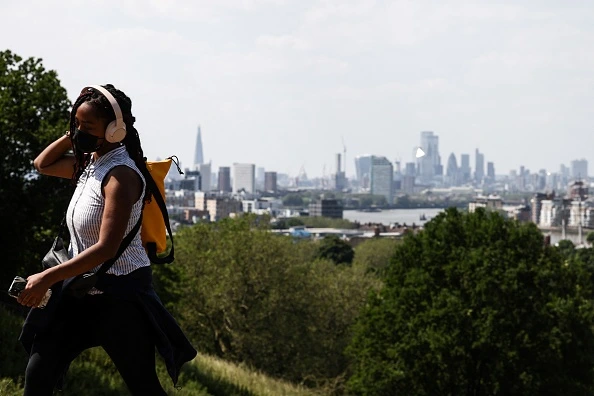
The World Health Organisation (WHO) attributes millions of deaths every year to air pollution worldwide – seven million in 2020 to be precise. The only possible solution to ensure future generations a healthy environment, and cities to still be liveable, is to drastically reduce pollution levels, which would also reduce risks of lung cancer, heart disease and asthma.

Certain cities in the UK, especially the biggest metropolises, already have plans in motion to purify the air and reduce pollution. London, Manchester, Birmingham, Leeds and Glasgow have already seen results deriving from their plans of action.
London
There are various myths that surround London’s air quality and pollution. One is that only central London is affected by air pollution when, in actuality, pollution affects every borough in the capital. Polluting vehicles contribute nearly half of the air pollution in London and turning off the engine when at a stop does significantly reduce pollution levels in the surrounding areas.
In order to control the pollution levels in the air, London has various initiatives in place. The main one is the introduction and expansion of the Ultra Low Emission Zone (ULEZ). It was first introduced in 2019 and, since then, it has helped to reduce harmful nitrogen oxides (NOx) by 46% in central London, the smallest internal area, and by 21% in inner London, the surrounding areas. ULEZ affects everywhere inside the North (A406) and South Circular (A205) roads.
The reason why outer London is not included in these stats is that up until November 2022, it was not included in the equation. Then, it was announced by Mayor of London Sadiq Khan that the ULEZ would be extended starting from 29 August 2023, when the new chargeable area will include the whole of the Greater London Authority Limits. This expansion will make the ULEZ 18 times bigger. This decision was taken to “ensure five million more Londoners can breathe cleaner air”, as Khan explained.
Even before the ULEZ, London took the first step towards cleaner air in 2008 when it introduced its first emissions control scheme, the Low Emission Zone (LEZ). The plan was introduced to push drivers to buy cleaner vehicles rather than older diesel cars.
The ULEZ subjects drivers to charges. Any vehicle that falls outside the guidelines is required to pay a £12.50 daily charge in order to travel inside the designated zones. For example, gasoline cars need to meet conditions such as the Euro 4 emission requirements if registered from 1 January 2006, while diesel vehicles follow the Euro 6 emission standard if registered from 1 September 2015.
Manchester
Some of the busiest roads in Manchester record unhealthy levels of air pollution, which can ultimately lead to damaging consequences like asthma, heart disease, stroke and even some cancers. According to Clean Air Greater Manchester, pollution is the cause of almost 1,200 premature deaths in the city every year.
Before the pandemic, the UK’s second city introduced its first Clean Air Plan, which included Clean Air Zone fees in some areas. However, after 2020, the government decided that this plan would not go ahead since the pandemic caused vehicle supply chain issues, raised vehicle prices and exacerbated the cost of living. In addition, it would have not achieved the government’s set objective of taking care of all harmful nitrogen dioxide in Manchester by 2024.
The new Clean Air Plan does not include a charging Clean Air Zone, since the city did not want it to have an impact on the economy. However, as the plan outlines, private cars, motorbikes and mopeds are not included in the non-charging zone.
There are four main steps the new Clean Air Plan oversees, and they are all investment-led:
- Target the most polluted areas since research has shown that harmful pollution will become more localised from 2025.
- Thanks to the government’s £120m Clean Air funding, the city can tackle vehicle upgrades rather than daily charges.
- Keep upgrading Manchester’s buses, as over 90% of the fleet already meets the emission standards set out by the government thanks to the Clean Air Bus fund. In September 2023, 100 new zero-emission buses will be introduced, and another 170 in 2024.
- The Clean Air Plan will also focus on reviewing local policies and regulatory measures.
The Clean Air Plan is not completely approved yet, however. In January 2023, the government asked for further evidence to support that a plan like this is needed and, even if the request has been fulfilled, Greater Manchester leaders did not agree on the necessity of a Clean Air Plan. Detailed modelling of the plan will now be submitted by July 2023, but the conversations are still ongoing.
Apart from the Clean Air Plan, Manchester has mobilised other initiatives to reach a less polluted future. For instance, it funded the free city centre bus and introduced bus gates to make travelling by public transport quicker and easier. In addition, Greater Manchester has also improved bus and cycle lanes along the main roads and widened footpaths.
Birmingham
In 2021, the city of Birmingham first introduced its second Air Quality Action Plan, which outlines all the procedures and projects to complete with 2026 as a deadline. The first plan was introduced in 2011, and it ensured the extension of the red route network to better connect the inner and outer parts of the city, increase the number of Park and Ride schemes, and extended the bus and taxi fleet.
With the newly drafted 2021 plan, Birmingham City Council opened a Clean Air Zone to balance out the air quality and pollution levels in the zone, and outlined seven main courses of action, including implementing the Clean Air Zone and promoting alternatively fuelled vehicles.
Within the Air Quality Action Plan, Birmingham outlined a Clean Air Strategy. In order to support these initiatives, the city has also collaborated with some organisations such as the Transport for West Midlands and The Rail Safety Standards Board.
Among the six pledges the project looks to achieve, the Birmingham Transport Plan 2031 aims to reallocate road space and completely transform the city centre with the introduction of pedestrian-only streets and public green spaces.
Every 12 months, the city of Birmingham will oversee a revision of these action plans and change them accordingly if needed.
Leeds
Leeds also drafted a Clean Air Zone plan in 2017, which included daily charges for specific vehicles. In order to help the economic situation, the city also provided financial support to businesses to promote the adoption of more environmentally friendly vehicles.
The plan revolves around transport, active travel, health, homes and businesses. When it comes to transport, Leeds committed to switching the council’s own vehicles to electric, including bin lorries, as well as installing new bus lanes. By introducing a public bike share scheme and making cycle lanes more navigable, the city has greatly improved its chances to reach the target. Schemes like Better Homes Leeds also play their part, since existing homes are being upgraded with energy-saving measures, alongside council housing.
From the beginning, this initiative, alongside other smaller schemes to tackle pollution, has shown great results. For example, in 2021, pollution levels exceeded limits only in a few areas and, thanks to the division into six Air Quality Management Areas, more parts of the city have become compliant with regulations.
Compared with pre-pandemic levels, recent studies have proved that air pollution in Leeds has diminished significantly. The city’s Air Quality Strategy aims indeed to achieve the WHO targets for air quality by 2030.
Glasgow
Since announcing its first Air Quality Action Plan in 2004, Glasgow has been making significant progress in tackling air pollution. The 2004 document outlined various Air Quality Management Areas in the Scottish city, among which are the city centre and Dumbarton Road and Byres Road.
In November 2022, the Annual Progress Report on Air Quality revealed that the last two roads, in particular, saw great improvements. Dumbarton Road and Byres Road have met the air quality objectives steadily every year since 2017 and, therefore, were stripped of their Air Quality Management Area (AQMA) status.
“It is encouraging that sustained improvements to air quality on both Byres Road and Dumbarton Road mean that council officers can now seek to have the Air Quality Management Area revoked,” Councillor Angus Millar, the City Convener for Transport and Climate, told Air Quality News.
Glasgow’s action plan aimed to reduce the levels of both nitric oxide and particulate matter in the city. Today, the city centre still remains a problem area, but on 1 June 2023, Glasgow announced the introduction of its first LEZ. Following the zone’s rules, every vehicle that drives through the city centre is subjected to a £60 non-compliance fee, effectively banning these vehicles rather than giving them the possibility to pay a smaller daily charge while still parking in the areas.
This latest LEZ is an extension of a bus-only LEZ that has been operative since 2018 and, from 2023, Glasgow became the first Scottish city to extend coverage to all private cars as outlined in the Transport (Scotland) Act 2019. Aberdeen, Dundee and Edinburgh also have plans to follow suit in 2024.
[Read more: London air pollution: Expanding the ULEZ is good but it won’t work by itself]






